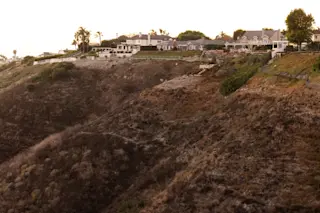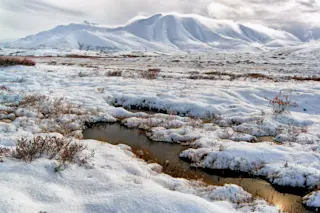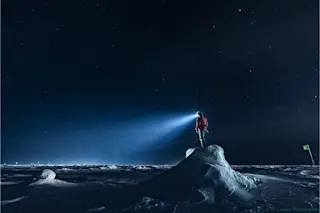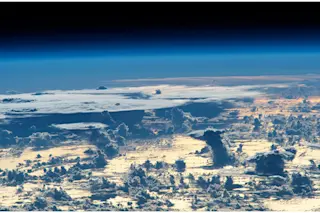
Researchers camped on the Greenland ice sheet hit bedrock this week after almost three years of drilling, reaching a depth of 8,000 feet. They hope that the ice they've uncovered from some 120,000 years ago, might give them a better understanding of what a warmer future might look like, if Greenland has less ice and the sea level rises. The team, which is part of the North Greenland Eemian Ice Drilling (NEEM) project, is looking to learn more about carbon dioxide levels during the Eemian period, when global temperatures were over 2-3 degrees Celsius warmer and sea level was about 15 feet higher. They believe these conditions might mirror effects caused by the earth's changing climate during the next century.
Scientists believe that by the end of the 21st century the planet will experience similar conditions again. Over the Greenland ice sheet, temperatures at the height of the Eemian may have been around 5 degrees Celsius warmer--mirroring the Arctic amplification of modern climate change. . . There are large uncertainties concerning the response of ice sheets to warming air and ocean temperatures. Understanding what happened to the Greenland ice sheet during the Eemian could help constrain projections of future sea level rise. [Nature]
The 120,000-year-old piece of ice retrieved this week was once snow. After about 200 feet worth of more snow piled on top, the pressure transformed that snow into ice, at the same time capturing atmospheric air in bubbles still present. Researchers hope to analyze the air inside to get the first Northern Hemisphere record of the carbon cycle from this period, by looking for concentrations of carbon dioxide in the bubbles.
Modern techniques that simultaneously measure selected chemical components, CO2 gas and CO2 gas isotopes. . . allow us to produce a high resolution CO2 record for Greenland. The record will be the first Northern Hemisphere record that provides information about the cycling, sources, and sinks of CO2. [NEEM project]
After removing outer layers of ice samples (to avoid contamination) researchers will melt or crush the ice (here's a neat picture of the "crusher needles") and then analyze the extracted air using laser absorption spectroscopy--researchers zap samples with laser light, and then measure the isotopic composition of the carbon dioxide that's emitted. Additionally, researchers hope the samples might give them another glimpse of life that existed before the Eemian.
The last 2 m of ice above the bedrock contains rocks and other material that has not seen sunlight for hundreds of thousands of years. We expect the ice to be rich in DNA and pollen that can tell us about the plants that existed in Greenland before the site became covered with ice, perhaps as long as 3 million years ago. [NEEM project]
The team has also kept an online journal during their work in northwest Greenland. An excerpt from this week's entry:
After a few runs with no penetration and totally grinded down cutters we made the decision to terminate the deep ice core drilling. We celebrated this with a glass of champagne in the drill trench and every nation present gave a small speech. . . . To imagine--it is done!! [NEEM journal]
Related content: 80beats: In a Warmer World, Iceland’s Volcanoes May Get Even Livelier 80beats: Antarctic Ice Melt Would Shift Earth’s Axis, Further Changing Sea Level 80beats: Once Again, Cold Weather Doesn’t Disprove Global Warming 80beats: NOAA’s Conclusive Report: 2000s Were Hottest Decade on Record
Image: NEEM













